
Data Encoding
Modulation -: a process of encoding data onto a carrier signal.

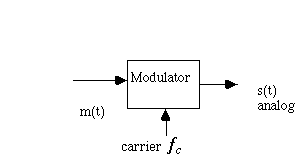
m(t) may be digital or analog. s(t) is analog.
There are three basic kinds of modulation:
AM, FM and PM
A digital signal is a sequence of discrete signal elements.
R=bit rate (bps)
![]()

mark = 1, space = 0
Nonreturn to zero (NRZ)
Two flavors: Nonreturn-to-Zero-Level (NRZ-L)
0=high, 1 = low
Nonreturn to zero Inverted (NRZI)
0= no transition at beginning of interval (one bit time)
1=transition at beginning of interval
transitions always occur at the beginning of the bit time.
NRZI is a differential encoding (encodes the differences between adjacent signal elements).
NRZ codes have a level voltage during a bit interval. They also carry a DC component and this may be a drawback. There is also no sync capability.
RS232, RS422, etc., are NRZ based standards.
NRZI (Nonreturn to Zero, invert on ones) has the advantage that it may be more reliable to detect a transition in the presence of noise than to compare a value to a threshold.
Multilevel Binary
These codes use more than two signal levels.
For example, bipolar-AMI (alternate mark inversion) and pseudoternary.
In bipolar-AMI,0= no line signal, 1= positive or negative level, alternating for successive ones (see figure 3-2).
Properties of bipolar-AMI
* no loss of sync for a long string of 1's...but a long string of zeros is still a problem.
* Since the zeros are at 0 volts and the ones alternate there is no net DC component.
* Bandwidth required is reduced from NRZ
* Pulse alternation provides error detection
Pseudoternary := 0 = positive or negative level, alternating for successive zeros, 1= no line signal.
* no loss of sync for a long string of 0's...but a long string of zeros is still a problem.
* Since the 1's are at 0 volts and the ones alternate there is no net DC component.
* Bandwidth required is reduced from NRZ
* Pulse alternation provides error detection
Bipolar-AMI and pseudoternary have no advantage over one another.
Information Measure
(not in book but A Good Quiz question!)
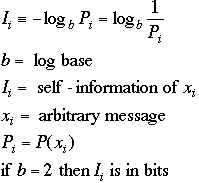
Example: A computer program generates 12 tones with equal probability. How many bits of information are contained in the statement: The computer played an A#.
Example:
Given bipolar-AMI, each symbol may take on 3 values, yet represents
only 1 bit of information. If the 3 symbols were equiprobable
then the amount of information that could be transmitted, in bits
per symbol is:
![]()
You should be able to compute information.
Biphase
All biphase techniques use one or two transitions per bit time.
* Biphase codes are self-clocking.
* They have no dc-component
* The mid-bit transition can be used for error-detection
* Uses more bandwidth than multi-level codes. i.e. Bipolar-AMI
and pseudoternary.
Manchester and Differential Manchester are Biphase codes.
Manchester
The middle interval transition provides clocking and data
0= transition from high to low in middle of interval
1= transition from low to high in middle of interval
note that the 1 pulse is 180 degrees out of phase with the 0 pulse.
Differential Manchester
Note: DM in figure 3-2 appears backwards from the text and caption.
There is always a transition in the middle of interval that provides
clocking.
0=no transition at the beginning of interval
1=transition at the beginning of interval.
CSMA/CD, Ethernet (IEEE 802.3) uses Manchester codes as do the F-16 subsystems (MIL-STD-1553B).
IEEE 802.5 is used in the token ring LAN via STP.
Modulation Rate
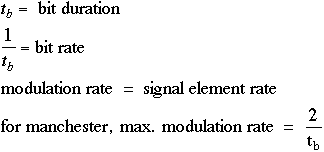
Scrambling Techniques
Self-clocking (biphase) codes require a higher modulation rate than non-self-clocking codes.
Scrambling techniques can achieve:
* No dc component
* no long sequences of 0-level line signals
* no data rate reduction
* error detection
B8ZS - bipolar with 8-zeros substitution (North America)
B8ZS = bipolar-AMI with a difference
In bipolar-AMI,0= no line signal, 1= positive or negative level, alternating for successive ones. (see figure 3-2).
Note that a long string of 0's results in a constant signal.
the B8ZS difference: If 8 0's occurs in the message and the
last pulse was positive, then the 8 0's are encoded as
000+-0-+
If 8 0's occurs in the message and the last pulse was negative then the 8 0's are encoded as 000-+0+-
See figure 3-5
Encoding Techniques
* ASK (amplitude-shift keying), AM,
2 amplitudes represent 1 and 0
![]()
good for fiber optic xmission.
* FSK (frequency-shift keying) FM,
Kansas-city standard, bell 108 modems

![]()
for full-duplex xmission, FDM is used.
FSK is less error prone than ASK
* PSK (phase-shift keying), PM (see fig 3.6)
in PSK a 0 is sent by sending a signal burst of the same phase
as the previous signal. A 1 is send by shifting the phase of the
signal 180 degrees with respect to the previous phase. This is
know has differential PSK, (DPSK).
![]()
Phase is measured relative to the previous bit interval.
Quadrature Phase Shift Keying (QPSK)
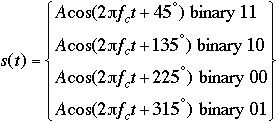
A signal element represents two bits...not one
We may also combine AM with PM and so by changing A we can further extend the number of bits per element.
This shows that the data rate, R (bps) and modulcation rate, D (in bauds) are different things.
Recall NRZ codes:
Two flavors: Nonreturn-to-Zero-Level (NRZ-L)
0=high, 1 = low
Nonreturn to zero Inverted (NRZI) (AKA nonreturn to zero invert on ones)
0= no transition at beginning of interval (one bit time)
1=transition at beginning of interval
transitions always occur at the beginning of the bit time.
NRZI is a differential encoding (encodes the differences between adjacent signal elements).
The data rate in NRZ-L is:

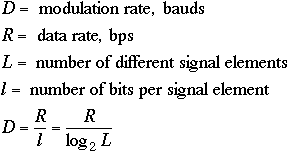
for an QPSK encoded NRZ-L signal:

so ![]() ,
that is the data rate is twice the baud rate for a NRZ-L code
with QPSK modulation.
,
that is the data rate is twice the baud rate for a NRZ-L code
with QPSK modulation.
Performance
for ASK (Amplitude-shift keying)
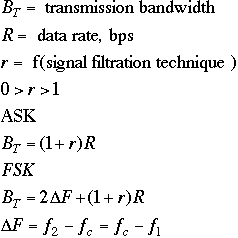
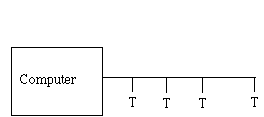
A multipoint topology. FSK in one of the coaxial cable multipoint local networks uses:
![]()
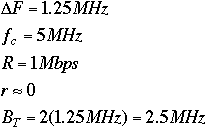
For the Bell 108 modem
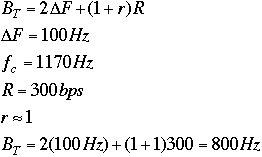
For multilevel signaling

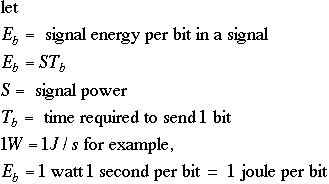
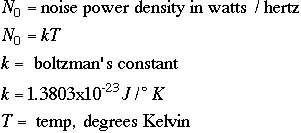
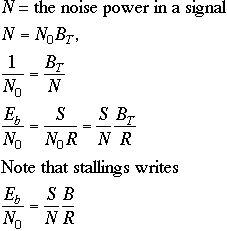
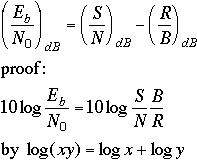
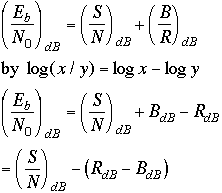

and so

must also be true.
also

Do example on pp 112.
3.3 Analog Data, Digital Signals
A/D conversion-digitization
After the signal is digitized you can do:
1. Xmit via NRZ-L (Nonreturn-to-Zero-Level)
2. encode via another method, then xmit
3. modulation of the data via a codec (coder-decoder)